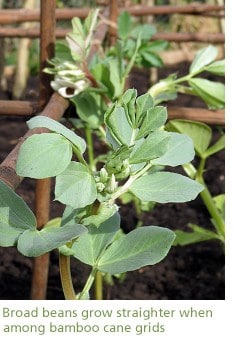In need of support.....
 The longer I go on growing my own veg, the more support I need.
The longer I go on growing my own veg, the more support I need.
It was all so simple when I started. All I needed was a few little wigwams. You know the kind of thing; stick five bamboo canes in the ground in a rough circle, tie the tops together and you’re done. They work anywhere: containers, veg beds, in among the flowers; and they take seconds to construct.
But no: I couldn’t be happy with just that, could I.
It was the start of a long and slippery slope. Garden peas on wigwams just looked a little… well… odd, really. And they did get tangled up with each other. So I tried pea netting: efficient but hideous. And while you’re supposed to be able to re-use them year after year, I defy anyone to roll up a length of pea netting at the end of one season in such a way that it is then possible to extract it the following spring without it disintegrating into a knotty bird’s nest of green nylon.
Pea sticks are what the pros use: I’ve tried hazel, birch prunings, bits of buddleja and lilac – just about anything that’s vaguely woody and twiggy. They’ll hold up smaller varieties quite nicely, but anything larger and they collapse under the strain.
Wigwams of (very) rustic hazel poles waiting for the French beans
So, since I have a weakness for Telephone peas – a catch-all term for classic Victorian six-footers. Two types of support were needed: twiggy peasticks for the Meteors, and that A-frame again for the whoppers. I’m told if you tie them in the middle – more of an X than an A – the peas dangle off the upper half of the supports rather conveniently for picking. One to try this year, I think.
 For the sweet peas, I’ve got funny little whippy hazel wigwams – a support of my own invention. The seed of the idea was planted when I saw the intricately woven supports of birch brush they use in the herbaceous borders at RHS Wisley. Each year, I cut a lot of one-year-old hazel whips, unbranched and about 8ft tall, then stick them in the ground at each corner of a 1ft square. Then I bend over the tops and weave them into each other in pairs to make a cross at the top; tie in the ends so they don’t stick out and you’ve got a sort-of wigwam, but much prettier. A bit like a hazel obelisk, really. It works in large-ish pots, too.
For the sweet peas, I’ve got funny little whippy hazel wigwams – a support of my own invention. The seed of the idea was planted when I saw the intricately woven supports of birch brush they use in the herbaceous borders at RHS Wisley. Each year, I cut a lot of one-year-old hazel whips, unbranched and about 8ft tall, then stick them in the ground at each corner of a 1ft square. Then I bend over the tops and weave them into each other in pairs to make a cross at the top; tie in the ends so they don’t stick out and you’ve got a sort-of wigwam, but much prettier. A bit like a hazel obelisk, really. It works in large-ish pots, too.
Then last year I discovered that mangetout peas are much easier to harvest if you grow them up a sort of diamond trellis out of shortened bamboo canes, stuck in the ground at an angle and tied together where they crossed. It worked a treat. And the broad beans – never very successfully supported by the canes-in-corners-linked-with-string method recommended in the books (as the beans grow bigger, the string bulges, requiring more string to lace it all in again later in the season) – are now given a sturdy home-made grid of canes.
 They’re supposed to be self-supporting, but not ‘Aquadulce Claudia’ – much too tall, and in any case after a mild-ish winter they tend to grow a little long and lanky and need a bit of propping up. The grid is suspended about a foot off the ground on bamboo ‘legs’; a second grid goes on later in the season, to catch the taller stems. Result: firmly held broad beans, no bulging, great crops.
They’re supposed to be self-supporting, but not ‘Aquadulce Claudia’ – much too tall, and in any case after a mild-ish winter they tend to grow a little long and lanky and need a bit of propping up. The grid is suspended about a foot off the ground on bamboo ‘legs’; a second grid goes on later in the season, to catch the taller stems. Result: firmly held broad beans, no bulging, great crops.
I’m aware that I’m probably being a little OCD about this but it really is worth varying your supports according to the crop you’re growing. They all have their little quirks and idiosyncrasies: and besides, inventing things out of bits of stick and string is in the best allotment traditions and can result in some ingenious solutions to knotty problems (pun intended).
Oh, and by the way: get them in the ground now. When you’re racing down the garden with ten minutes spare to plant out a tray of runner bean seedlings the last thing you’ll want is to stop and do stick-and-string origami. Get them in place as you start sowing, and they’re ready and waiting to support your veg right through the year.



 The longer I go on growing my own veg, the more support I need.
The longer I go on growing my own veg, the more support I need. For the
For the  They’re supposed to be self-supporting, but not ‘
They’re supposed to be self-supporting, but not ‘